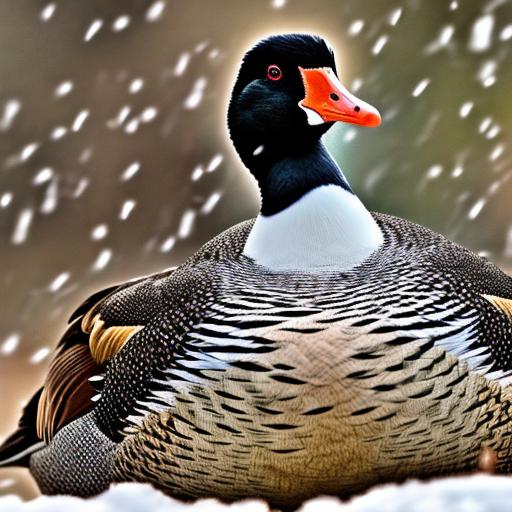When raising geese, it is important to prepare for the winter months to ensure the health and well-being of your flock. Geese are hardy birds that can withstand colder temperatures, but they still require special care during the winter. Factors such as insulation, bedding, heat lamps, and proper nutrition all play a role in keeping geese warm and healthy during the colder months.
Key Takeaways
- Geese need extra care during winter to stay healthy and warm.
- Coops should be prepared for winter with insulation and heat lamps.
- Adequate bedding, such as straw bales, can help keep geese warm.
- Fresh water and a high-calorie diet are important for geese in winter.
- It’s important to monitor geese for signs of cold stress and be prepared for emergencies.
Understanding the Winter Needs of Geese
Geese have natural behaviors that help them adapt to colder temperatures. They will fluff up their feathers to create an insulating layer of air, which helps to keep them warm. They will also huddle together in groups to share body heat. Additionally, geese have a higher metabolic rate during the winter, which helps them generate more body heat.
However, there are still health risks that geese face during the winter. Frostbite is a common concern, especially on their feet and wattles. Respiratory issues can also arise if the coop is not properly ventilated, leading to dampness and mold growth. It is important to be aware of these risks and take steps to mitigate them.
Preparing the Coop for Winter
One of the most important aspects of preparing for winter is ensuring that the coop is well-insulated. This will help to keep the cold air out and retain heat inside the coop. There are several materials that can be used for insulation, such as straw bales, foam boards, or even recycled denim insulation.
In addition to insulation, it is crucial to seal any gaps or cracks in the coop to prevent drafts. Gaps can be sealed with caulk or weatherstripping, while cracks can be filled with expanding foam or wood filler. This will help to keep the coop airtight and prevent cold air from entering.
Providing Adequate Bedding for Geese
Bedding is another important factor in keeping geese warm during the winter. Straw is a popular choice for bedding, as it provides insulation and is comfortable for the geese. It is important to regularly clean and maintain the bedding to prevent the buildup of moisture and bacteria.
It is also important to provide enough bedding for the geese to stay warm. A thick layer of straw will help to insulate the floor of the coop and provide a comfortable surface for the geese to rest on. The bedding should be regularly replaced to ensure cleanliness and warmth.
Using Heat Lamps to Keep Geese Warm
Heat lamps can be a useful tool in keeping geese warm during the winter. They provide an additional source of heat in the coop, which can be especially beneficial during extremely cold temperatures. Heat lamps should be installed safely, with proper ventilation and secure mounting.
It is important to monitor the temperature in the coop when using heat lamps. The ideal temperature for geese is around 40-50 degrees Fahrenheit. If the temperature drops too low, additional heat sources may be needed. Conversely, if the temperature rises too high, it can lead to overheating and discomfort for the geese.
Insulating the Coop for Maximum Warmth

In addition to insulation, there are other ways to maximize warmth in the coop. One method is to use reflective insulation, such as foil-backed foam boards, on the walls and ceiling of the coop. This will help to reflect heat back into the coop and prevent it from escaping.
Proper ventilation is also important in maintaining warmth in the coop. While it may seem counterintuitive, ventilation helps to remove moisture and prevent condensation, which can lead to dampness and mold growth. Ventilation should be located near the roofline to prevent drafts.
Using Straw Bales to Keep Geese Warm
Straw bales can be used as an additional source of insulation in the coop. They provide a thick layer of insulation and can be arranged around the perimeter of the coop to create a barrier against cold air. Straw bales also provide a comfortable surface for the geese to rest on.
When using straw bales, it is important to properly arrange them to ensure maximum insulation. They should be stacked tightly together and placed against the walls of the coop. It is also important to regularly replace straw bales, as they can become damp and moldy over time.
Providing Plenty of Fresh Water
Providing fresh water for geese during the winter is crucial for their health and well-being. Geese require water for digestion and hydration, even in colder temperatures. However, water can easily freeze in winter, so it is important to take steps to prevent this.
There are several methods for preventing water from freezing. One option is to use heated waterers, which have built-in heating elements that keep the water from freezing. Another option is to use insulated waterers, which help to retain heat and prevent freezing. It is important to regularly check and refill the waterers to ensure that the geese have access to fresh water at all times.
Feeding Geese a High-Calorie Diet in Winter
Feeding geese a high-calorie diet during the winter is important for maintaining their weight and energy levels. Geese require more calories during colder temperatures to generate body heat and stay warm. This can be achieved by providing them with a diet that is higher in fat and carbohydrates.
There are several types of food that can be given to geese during the winter. This includes grains such as corn, wheat, and barley, as well as high-fat foods like sunflower seeds or cracked corn. It is important to provide enough food for the geese to maintain their weight, as weight loss can make them more susceptible to cold stress.
Monitoring Geese for Signs of Cold Stress
It is important to monitor geese for signs of cold stress during the winter. Cold stress can lead to health issues such as frostbite, respiratory problems, or even death. Signs of cold stress in geese include shivering, huddling together, decreased activity, and loss of appetite.
To properly monitor geese for signs of cold stress, it is important to observe their behavior and physical condition regularly. This can be done by spending time with the geese and observing their interactions. If any signs of cold stress are observed, it is important to take action immediately to prevent further complications.
Preparing for Emergencies in Winter
Winter can bring about emergencies that require immediate attention. This can include power outages, extreme weather conditions, or even illness or injury among the geese. It is important to be prepared for these emergencies and have a plan in place.
One way to prepare for emergencies is to have a backup power source, such as a generator, in case of a power outage. It is also important to have emergency supplies on hand, such as extra bedding, food, and water. Additionally, it is crucial to have a plan for transporting sick or injured geese to a veterinarian if needed.
Preparing for winter when raising geese is essential for their health and well-being. By understanding their winter needs and taking the necessary steps to provide insulation, bedding, heat lamps, fresh water, and a high-calorie diet, you can ensure that your geese stay warm and healthy during the colder months. Monitoring them for signs of cold stress and being prepared for emergencies will also help to keep them safe. By taking these steps, you can ensure that your geese thrive throughout the winter season.
If you’re interested in keeping geese warm during the winter, you might also find this article on “The Chicken Coop Country Diner” from Poultry Wizard helpful. It provides valuable insights into creating a cozy and comfortable environment for your feathered friends. From proper insulation to effective heating methods, this article offers practical tips to ensure your geese stay warm and healthy throughout the colder months. Check it out here.
FAQs
What temperature range can geese tolerate?
Geese can tolerate temperatures ranging from 32°F to 70°F. However, they can survive in temperatures as low as 20°F if they are provided with adequate shelter and warmth.
What kind of shelter is suitable for geese in winter?
A suitable shelter for geese in winter should be well-ventilated, dry, and draft-free. It should also be large enough to accommodate all the geese and provide them with enough space to move around. The shelter should be insulated and have a bedding material such as straw or hay to keep the geese warm.
How can I keep my geese warm in winter?
You can keep your geese warm in winter by providing them with a suitable shelter, insulating the shelter, providing them with bedding material, and providing them with a heat source such as a heat lamp or a heated waterer. You can also feed them a high-energy diet to help them generate body heat.
What kind of bedding material is suitable for geese in winter?
Straw or hay is a suitable bedding material for geese in winter. It provides insulation and helps to keep the geese warm. You should ensure that the bedding material is dry and clean to prevent the geese from getting sick.
What kind of diet should I feed my geese in winter?
You should feed your geese a high-energy diet in winter to help them generate body heat. This can include grains such as corn, wheat, and barley, as well as high-protein feeds such as soybean meal. You should also provide them with fresh water and ensure that it does not freeze.
Meet Walter, the feathered-friend fanatic of Florida! Nestled in the sunshine state, Walter struts through life with his feathered companions, clucking his way to happiness. With a coop that’s fancier than a five-star hotel, he’s the Don Juan of the chicken world. When he’s not teaching his hens to do the cha-cha, you’ll find him in a heated debate with his prized rooster, Sir Clucks-a-Lot. Walter’s poultry passion is no yolk; he’s the sunny-side-up guy you never knew you needed in your flock of friends!







